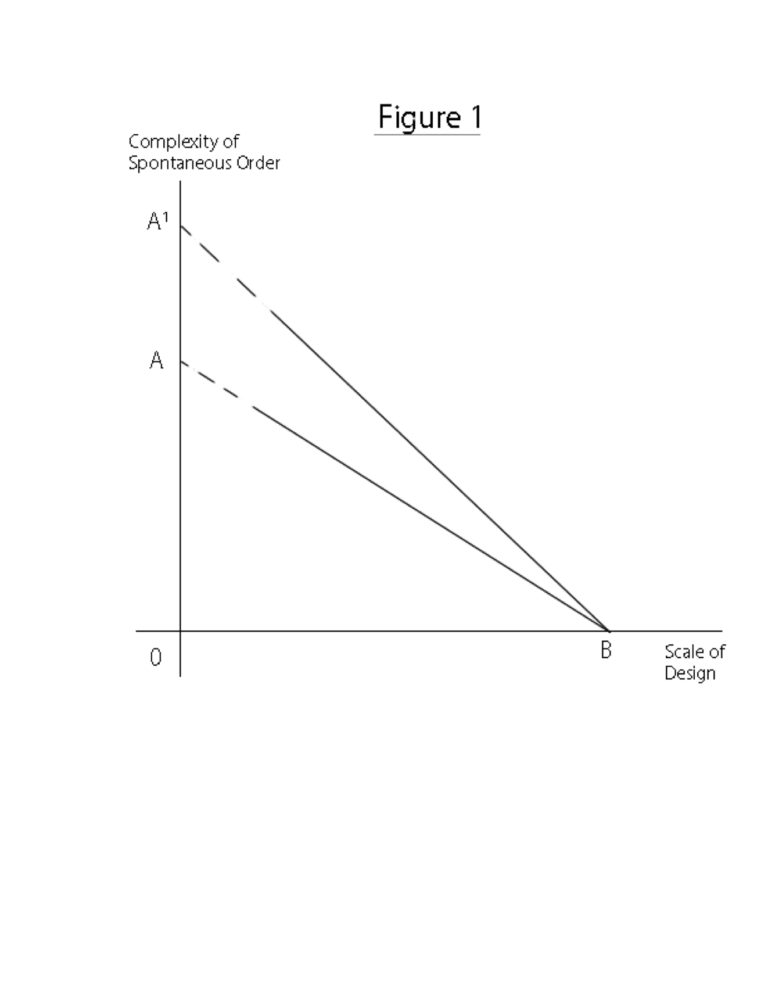Physical Address
304 North Cardinal St.
Dorchester Center, MA 02124
Physical Address
304 North Cardinal St.
Dorchester Center, MA 02124

We can visualize the tradeoff between the scale of design and the complexity and spontaneity of a social order as a downward-sloping curve. A sort of “scale-versus-order-possibilities frontier.” In addition to scale and spontaneous order/complexity, a third element I would add to the tradeoff is the passage of time. You can to some extent plan for complementarity, but you can’t really plan for spontaneous complexity and intricacy. [Helpful to bring in capital theory here?] Fortunately, time allows people to some extent to adjust social networks and physical spaces to better complement their own plans, in ways that the designer could not foresee. That is, for any given scale, time lets people figure out novel uses for, or changes to, the space as originally designed. Those unthought-of uses constitute an increase in the level of complexity in a spontaneous order. Over time, then, the frontier can shift outward. Figure 1 reflects these relations: The scale of a structure and the designed or planned uses of the space within that structure are of course two different things. Increasing the dimensions of a room doesn’t necessarily mean the elements that go into its design become more complex. But to keep things simple, Figure 1 treats scale and design as highly positively correlated. [Is this necessary?] Thus, as scale increases so do the designed elements – you move from point A to point B – and together they decrease the potential for spontaneous order. [But think about the tradeoff between scale and order, keeping design constant. Just increasing scale does seem to increase the designed/planned element in a previously undesigned space.] Then, as time passes, the frontier shifts up from AB to A’B, where point B represents the case where the structure occupies100% of the relevant action space. So for any given scale, the […]
First of all, Jacobs observed that the artist abstracts from life, with all its “inclusiveness” and “literally endless intricacy.” Many architects, especially those with great ambition, seem to treat urban environments as merely a canvas for their works of genius, which if not already blank needs to be wiped clean before getting to work. The good ones at least try to take into account how their constructions fit or don’t fit into the existing built environment and how real people might actually use them. But whether you’re an architect or an economist, predicting how people will respond to a change is a pretty iffy thing. From my perspective that iffiness comes from two factors: complexity and radical ignorance. Complexity in this context means that the interactions among people are so numerous or varied or changeable that the costs of being aware of all of them is too high for anyone to calculate. Hayek defines the degree of complexity in terms of the “minimum number of elements of which an instance of the pattern consists in order to exhibit all the characteristic attributes of the class of patterns in question…” (Hayek 1964). In a world with only a few variables, such as those described in a high-school algebra problem, it is possible to have all the knowledge you need to get the correct answer. In the real world, however, the number of relevant variables is too large, that is the number of ever-changing interactions among people in society is so large, and our cognitive powers are too limited to do that. Compared to the vast complexity of the social order, predicting this week’s weather is a pretty simple matter. Radical ignorance means being unaware of information that would be relevant to making a decision, not because the cost is too high, […]